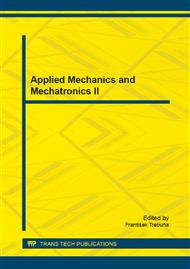p.160
p.165
p.174
p.182
p.188
p.195
p.204
p.213
p.224
Geometric Indicators of Flexible Slice Lip
Abstract:
The paper is thematically connected with paper making machines. This type of the machine is equipped with a head which has a flexible slice lip for skimming the pulp applied to produce the paper. The definition of geometric features of the slice lip is a key issue. The slice lip should be made of material which is resistant to external factors, and designers want to obtain a high flexibility of this element. It is possible to get a high flexibility by forming a proper shape of the slice lip. The paper presents the proposal of dimensionless geometric indicators which combine basic geometric parameters of the slice lip. These indicators are the following: indicator of the cross-section, indicator of the length and indicator of the length of the transverse notch. FEM strength analyses were done – the aim of these analyses was the determination of the stress state and maximum deflection of the slice lip. The authors have analysed the slice lip with holes for mounting the actuators and the slice lip and with transverse notches for increasing its flexibility. The results were presented in the form of graphs.
Info:
Periodical:
Pages:
188-194
Citation:
Online since:
November 2015
Keywords:
Price:
Сopyright:
© 2015 Trans Tech Publications Ltd. All Rights Reserved
Share:
Citation:


